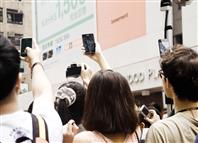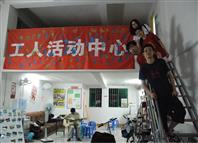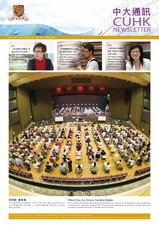In 2010, there was a series of staff suicides at the Foxconn factory, which has a reputation for being a sweatshop, putting the company on the front page for several months. At the height of the suicides, over 60 teachers and students from some 20 universities in mainland China, Hong Kong, and Taiwan, launched a joint investigation on the Foxconn incidents. Prof. Qiu Linchuan Jack, associate professor at the CUHK School of Journalism and Communication, produced a 20-minute short film entitled ‘Deconstructing Foxconn’ as a visual document of the investigation. He subsequently penned an article ‘Visual Action Research: Deconstructing Foxconn’ in Communication and Society, that explores visual action research and how to use visual tools to gain in-depth understanding of the work and lives of China’s labourers.
Professor Qiu said the video is not a comprehensive documentary but a visual footnote for the study. The film shows scenes of Foxconn workers going to and getting off work, with interviews of a veteran staff from Kunshan in Suzhou, Zhang Houfei, and suicide survivor Tian Yu. It ends with the workers’ lives outside office hours. The film unveiled some little known sides of Foxconn which were captured on smart phones by over 10 students who had entered the factory as summer workers. The short was completed in early October 2010, and by mid-November, was screened five times in cities including Beijing, Shanghai, Shenzhen, and Hong Kong. A few days after it was uploaded to the Sina Science and Technology Channel, it registered over 50,000 hits. The response was overwhelming and unexpectedly so. ‘Communication studies is lagging behind other disciplines in action research,’ remarked Professor Qiu. ‘Visual action research is an important channel through which we could catch up. The participation of Foxconn staff was crucial of course, but without the images, reports and discussion provided by smart phones and Internet media, there was no way the film could have achieved the effect it did.’
Simply put, action research is research conducted through actual participation in the activities of the research targets. And visual action research complements that with the use of audio-visual equipment. The point is not to shoot perfect footage, but to give a voice to the grassroots. Professor Qiu explained that in the Internet age, social classes are divided according to mastery of information technology. These include the ‘haves’, the ‘have-lesses’ and the ‘have-nots’. The imbalance among the three is called the digital divide or the digital discrepancy. ‘China has over 300 million Internet users, some 80% of whom read the news online. They’re the ‘haves’. About 700 million have mobile phones but don’t go online. They’re the ‘have-lesses’. The rest are the ‘have-nots’ who have minimal contact with information. There are about 300 or 400 million of them.’
The emergence of new media such as mobile phones and the Internet has brought changes to the modes of mass communication with deep and far-reaching consequences. Social events carried in new media are called ‘new media events’. New media, cheap and allowing participation by the masses, have become a new research area in communication studies. Professor Qiu said, ‘New media events can overcome existing journalistic systems to give the masses a voice. The developmental direction of social events becomes from bottom to top. The speed of communication is faster and there’s more interaction, and overcoming of boundaries. The Foxconn incident is a case in point.’
The New Media Event Database of the School of Journalism and Communication has collected over 400 new media events that can be categorized by content into ‘nationalism’, ‘struggle for rights’, ‘ethics and privacy’ and ‘abuse of public power’. Professor Qiu pointed out that there is much difference between the communication of new media in mainland China, Hong Kong, and Taiwan. In the first, they happen with greater frequency, they’re highly independent, and less reliant on public media. The most symbolic event was the fire of the CCTV headquarters in 2009. The people captured the fire scene with their phones and digital cameras and uploaded the images to the Internet—a classic example of how citizen journalism has surpassed television journalism. The most sensational new media events in Hong Kong and Taiwan also spawned legal or moral issues. There were even serious discussions of rights to privacy, freedom of speech, and Internet monitoring. But by nature, these incidents were closer to daily life, like entertainment gossip, such as Edison Chen’s ‘erotic photo leak’ and Taiwan’s ‘new 228 incident’ on the Ptt online bulletin board. Professor Qiu explained, ‘The mainland, Hong Kong, and Taiwan have their own technological features and social backgrounds, so new media events have different functions in each of these places. This shows that communication technology is inseparable from social structure. Researchers should take into account the expanding ecological system of the media, and the underlying political, economic, social and cultural systems, in order to develop new media events research more comprehensively.’ 



































































































































































Social Bookmarks